 |
||
|
||
| ||
It is interesting why such a giant as VIA fails to produce a chipset operating at the maximum possible speed from the first. Only in a month or two the performance grows up by some 10%. In the time of Apollo Pro 133 the upgrade up to the Apollo Pro 133A was conceivable, but the KT266A and the P4X266A make a real mystery. Well, I have two ideas why it is so: either the engineers didn't have enough time as they are urged on by the marketing department, or the speed wasn't originally the highest possible so that it might be possible to have some trumps. Tested mainboardsASUS A7V266-EThe board is identical to the VIA KT266 based one. The engineers just changed a northbridge chip leaving the rest of the components as is. I must say that almost all other manufacturers followed this way as well. 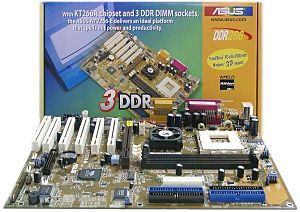 A traditional box contains a user's manual in English, a short installation manual in several languages, 2 ATA100 and FDD cables, a bracket for a rear computer panel with two USB ports and a CD-R (drivers, Adobe Acrobat Reader 4.05, PC-Cillin2000 v. 7.0 from Trend Micro, Power Player SE 5.0, PowerDVD Trial 3.0, VideoLive Mail 4.0 from CyberLink, 3Deep for adjusting color balance in games, and ASUS programs - screensaver, ASUS Update and ASUS PCProbe (system monitoring utility). 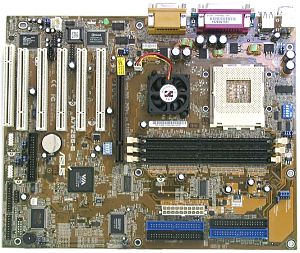 The board incorporates an IDE RAID controller from Promise with ATA100 connectors. Besides, the board is equipped with an audio chip from C-Media featuring a 6-channel sound output. But a bracket for audio-outs of the rear panel is absent, and Line-In and Mic-In connectors, thus, become outputs of central and rear channels with the help of the drivers. The only drawback is location of an FDD connector: it is placed behind 4 and 5 PCI slots, thus making the cable stretch along the whole case. The board has 4 3300uF and 3 1500uF capacitors. Besides, there are SMARTCARD and AFPANEL connectors (the latter is meant for connecting ASUS iPanel). Among a great deal of jumpers the most interesting are 4 units of switches which are used to set a base processor frequency, a multiplier and Vcore. The fourth will help you choose a processor type - Athlon, Duron or Athlon 4 (Palomino). The most of settings are hidden in the BIOS Setup. The BIOS is based on version Medallion 6.00 from Award. It offers a great variety of modes for memory, AGP and PCI buses; you can manually distribute interrupts among PCI slots etc. With the JumperFree technology you can change many characteristics of the system in the BIOS Setup in the version of Asustek. For example, you can set Vcore (1.525-1.85V, 0.025V step), a CPU multiplier (x5-x13), and a FSB frequency (100-227 MHz(!) in 1 MHz steps). This board is one of the best in speed as compared with its today's contestants. MSI K7T266 Pro2 & K7T266 Pro2-RUThese boards differ only in two IDE RAID chips, that is why we will examine them together.  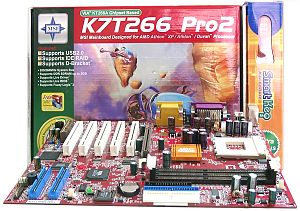 The boxes house boards on red textolite, a user's manual in English, a weighty manual for IDE RAID adjusting procedures (for the K7T266 Pro2-RU), two ATA66/100 and one FDD cables, a D-Bracket for a rear computer panel with D-Leds and 2 USB ports. There is also a bracket with 4 USB ports, a note how to make a correct choice of a cooler for the AMD processor, a diskette with drivers for IDE RAID and a CD. Besides, there is a SmartKey which comes in a separate box. The CD has drivers for motherboards, video cards and other products from MSI. Besides, there are Adobe Acrobat Reader, AMI and AWARD utilities for operation with Suspend-To-Disk function, WinFlash from AWARD for flashing BIOS from Windows, MSI programs such as LiveBIOS and Fuzzy Logic 3, PC Alert (which controls temperatures and fan speeds), GoodMem for deleting unnecessary programs from memory, X-Setup for adjusting some parameters of Windows, PCCillin 2000 - an antivirus program, 3Deep for adjusting color balance and VNC for a remote computer access. 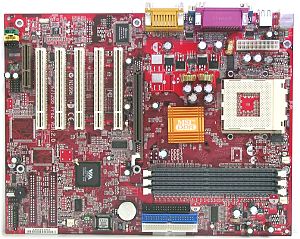 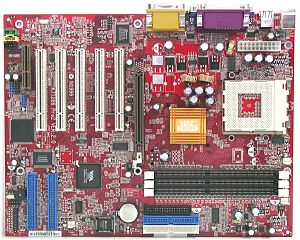 The boards are of high quality, and the layout is convenient. The K7T266 Pro2-RU incorporates a great deal of components. Here we have an IDE RAID on the Promise's chip, a USB controller 2.0 (we, thus, got up to 8! USB ports on a single board, with two being high-speed). The AGP connector has a clip to fix a video card. For the operation to be stable there are 6 capacitors. Besides, we have a piezoelectric speaker. The switches have standard functions such as CMOS clear-up, a possibility to start a computer from PS/2 devices etc. The BIOS is based on the AWARD Modular BIOS v.6.00PG. There are plenty of settings for memory timings and for AGP and PCI buses. You can also change an FSB frequency, voltage of the processor and memory. The boards passed all our tests and left a pleasant impression. Gigabyte 7VTX-PKT266 analog of this board was already tested in the review of the VIA KT266 chipset, and there is almost nothing to add. In a usual blue and white box you can find ATA66/100 and FDD cables, a user's manual, a bracket with two USB ports and a CD with drivers and utilities. Among the programs you can find Norton Antivirus 2001, Norton Personal Firewall 2001, EasyTune III for overclocking the system from the Windows, and @BIOS for updating the BIOS from Windows. 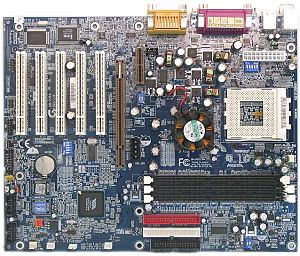 The board we tested previously differs from the today's one in an unsoldered connector for AGP slot extra feeding, and a fan from AVC on the heatsink of the north bridge. All elements are placed competently. Among other peculiarities there are CPU three-phase supply and 13 LowESR 1200uF capacitors. There are also switches for changing a FSB frequency and a multiplier and for adjusting voltage of the AGP bus and memory modules. The BIOS is based on v1.24 from AMI and helps to adjust timings of memory and an AGP bus, to change a FSB frequency in 1 MHz steps up to 180 MHz and to set a coefficient of correlation of AGP/PCI/FSB frequencies. I wish only there were a possibility to change Vcore. This new version of the Gigabyte board showed excellent results in our today's tests. DFI AD70-SRThis board is identical in design to the KT266 based board and even has the same name; a sticker with the revision number on the LPT port will let you know which board you have. Boards based on the VIA KT266A have it AA2 and higher. 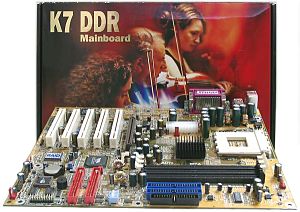 A standard box contains the board, a user's manual in English, French, German and Spanish, an installation manual for the IDE RAID, a sticker with description of main functional connectors and switches, a diskette with IDE RAID drivers, 3 ATA66/100 and one FDD cables, and a CD. The latter comes with drivers, a couple of monitoring utilities and PC-Cillin 2000 from Trend Micro. 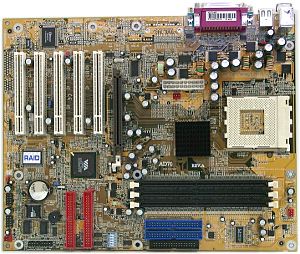 Quality of the board is high, but there are some tiny drawbacks in the layout, for example, IDE Raid connectors are located behind the PCI slots. This PCB is meant for several versions of VIA KT266/KT266A boards; and the one we have has a CNR expansion slot and an AC'97 sound controller unsoldered. A CPU's three-phase voltage stabilizer has 12 LowESR capacitors: 8 of 2700 uF and 4 of 1500 uF. There are several switches: to clear up the CMOS, to enable/disable the IDE RAID, to choose a FSB frequency (100 or 133 MHz) and a CPU multiplier. The BIOS is based on the Modular 6.00PG from Award and offers a wide range of settings for memory timings and AGP and PCI buses, manual distribution of interrupts among PCI slots, changeable Vcore and FSB frequency (in 1 MHz steps). On the whole, the board is not bad, but it has no any interesting peculiarities. Chaintech 7VJDAThis board doesn't differ from its predecessors based on the KT266 chipset. 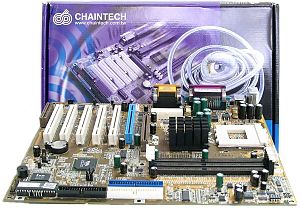 It is interesting that the Chaintech 7VJDA has 5 PCI slots, 1 CNR and 1 ACR. I think it would be better to replace a CNR or an ACR with one more PCI. The standard blue and purple box contains also a detailed description of the board and installation instructions, an 80-conductor ATA66/100 cable and an FDD one. The board comes with two CDs. One of them contains drivers for Chaintech boards, a utility CPUBoost to change a processor frequency and some other parameters right from the Windows, and a WinDVD program. The second CD named "Value Pack 2001" contains Adobe Active Share (for viewing photos, creation of albums and for their exchanging via the Net), Norton Antivirus 2001, Adobe Acrobat Reader 4.05, AutoSave, Ewalla (a partial substitute for an e-mail client with the help of funny animals and small cars), Appio (a personal helper for making purchases on the Net), and X-Stop (for access restriction to some sites). Such a software set is mainly intended for a usual user than for a professional. 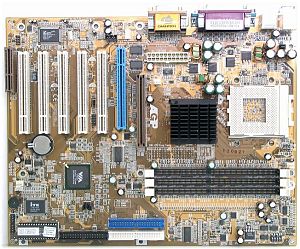 The layout is quite good except tiny downsides: power supply and audio-in connectors are placed not very conveniently. The audio solution from C-Media unloads the processor and lets you listen to the music on a 5.1 audio system. The board has 6 capacitors of 3300uF and 4 ones of 2200uF. There are also several jumpers for clearing the CMOS and for setting the base processor frequency - 100 or 133 MHz. The third one is made as a unit of switches for changing the processor multiplier. All other settings are included into the BIOS Setup. The BIOS based on the v6.00PG from Award will help you adjust memory modes, AGP and PCI buses modes, distribute interrupts manually among PCI devices and overclock the processor. The core voltage can be lifted by 0.35V in 0.025V steps, and the FSB frequency can be changed in 1 MHz increments up to 166 MHz. The board is rather good: it has almost everything an ordinary user needs. Jetway 866AS Ultra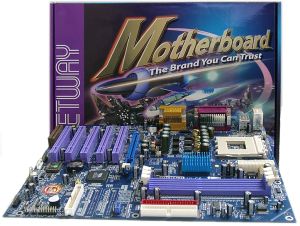 The board ships in a Retail package the design of which is very typical of MSI. Inside there is a weighty user's manual in English, and ATA66/100 and FDD cables. As you can see below the ATA66/100 cable is very easy to pull out of connectors. 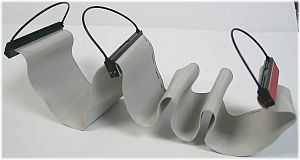 The CD supplied contains drivers, PC-Cillin 2000, several utilities for BIOS " WinFlash, MagicBIOS etc. and Recovery Genius - a program which reserves space on a hard drive and stores there backup copies. 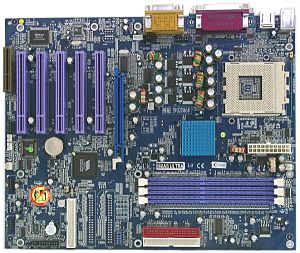 The board is based on blue textolite but it looks like a rainbow as all slots are of different colors. The layout is quite convenient. There is space for an unsoldered IDE RAID from Promise. A three-phase voltage stabilizer includes 9 capacitors of 1500 uF and 4 of 2200 uF. There are also switches which can be used to clear the CMOS, choose a CPU multiplier and a FSB frequency etc. The BIOS based on the Modular 6.00PG version from Award offers a lot of settings for memory and AGP and PCI buses. You can also change a FSB frequency, voltage of the core, memory and chipset and choose among AGP bus voltages - 1.5 V and 3.3 V. Although the speed characteristics of the board are not brilliant, you can squeeze out the CPU's maximum potential. Abit KR7A-RAID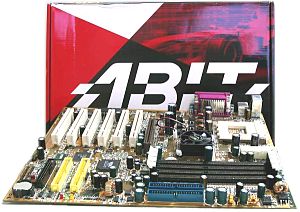 The board packed in a red box seems to be saying "Warning, hot!" :) Here we find a user's manual in English, 2 ATA66/100 and one FDD cables, a bracket with two additional USB ports for the rear computer panel and a CD. The latter comes with drivers, a monitoring utility and several free programs: Norton Antivirus 2002,WinDVD 2000 v2.1, 3Deep and BuzzSoft utilities " SoftPostCard, SoftCopier, SoftCardManager and SoftBulkEmail. 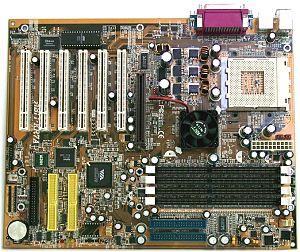 The quality of the board is excellent: all components are easy to reach except maybe IDE RAID connectors. The best advantage of this board is IDE RAID with the record speed of data exchange with a hard drive (133 MB/s). This controller is based on the HighPoint chip HPT372. Besides, there are three LEDs which mean 'power on', 'rebooting' and a Standby mode. A three-phase voltage stabilizer includes 5 LowESR capacitors of 3300 uF and 2 of 4700 uF. The board has only one switch meant for clearing up the CMOS. The BIOS based on the Modular v6.00PG version from Award contains SoftMenu of the third version. Here we can change a FSB speed in 1 MHz increments, a CPU multiplier and voltage of the processor, chipset and memory. There is also the widest choice of memory timings and of AGP and PCI buses. Interrupts can be manually distributed among PCI slots. The Abit board can be proud of a really high speed; though it is also rather stable and reliable. Soltek 75DRV2The company decided to leave the previous design as the it worked flawlessly. 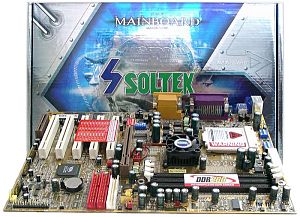 Inside the box we found a user's manual in English, software description, an ATA66/100 (80-conductor) cable, an FDD one and two CDs. One of the discs comes with drivers for the board, Adobe Acrobat Reader and several system monitoring utilities. The second one contains PC-Cillin 2000, Virtual Drive 6.0 and two PowerQuest programs " PartitionMagic 6.0 and Drive Image 4.0. 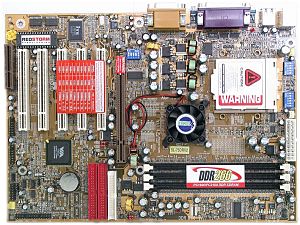 An AGP Pro connector allows us to use a video card with increased power consumption. The CPU circuits contain 6 capacitors of 3300 uF and 4 of 2200 uF. There are no flaws in the layout except only a CD-in connector which is put between the 1st and the 2nd PCI slots. Three units of DIP switches control Vcore, a CPU multiplier and a FSB frequency. Two of these parameters double in the BIOS. The BIOS is based on version 6.0 from Award and allows adjusting timings of the memory and the AGP bus. The BIOS also supports Red Storm Overclocking technology for overclocking a processor in the auto mode and AntiBurn Shield one which would prevent toasting the processor. Here you can also manually distribute interrupts among PCI slots. Well, the board features a good deal of functions, let's see whether it can outscore the others in our testing. PerformanceTest system:
Software:
Below is the table of characteristics of the tested boards:
Test results:Let's start with coding and archiving.  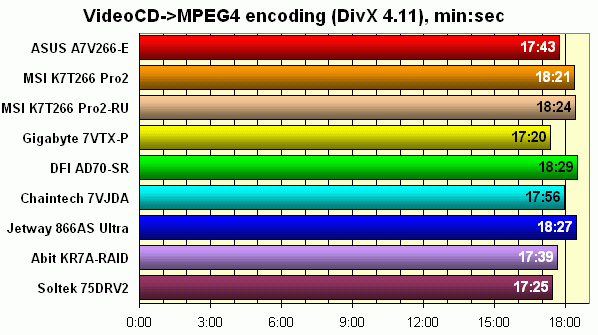 As we saw before, the Lame codec doesn't discern different memory types; moreover, there are no any difference between the boards based on the same chipset. Video coding is a more memory dependent test, that is why a difference reaches sometimes 6%. The Gigabyte and the Soltek boards have the best results while the DFI and the Jetway fall behind. 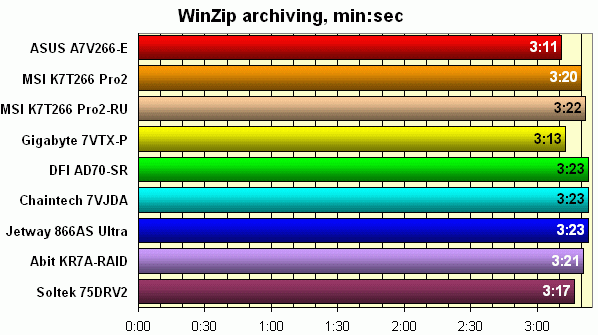 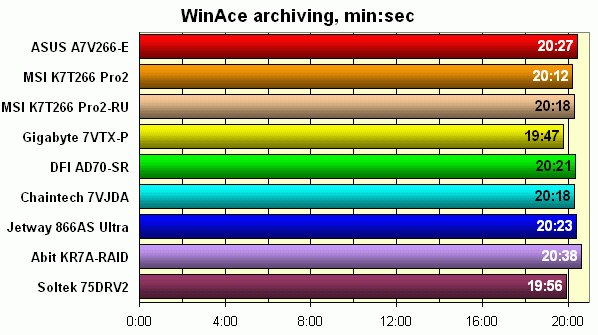 The WinZip also has a "swift" algorithm which stresses a memory disc subsystem rather than a processor that is why the difference is not huge again and the ASUS and Gigabyte outdo the others. The WinAce with its 4 MBytes dictionary and a more sophisticated algorithm makes the difference deeper; the Gigabyte and the Soltek go ahead and the Abit unexpectedly falls into the last position.  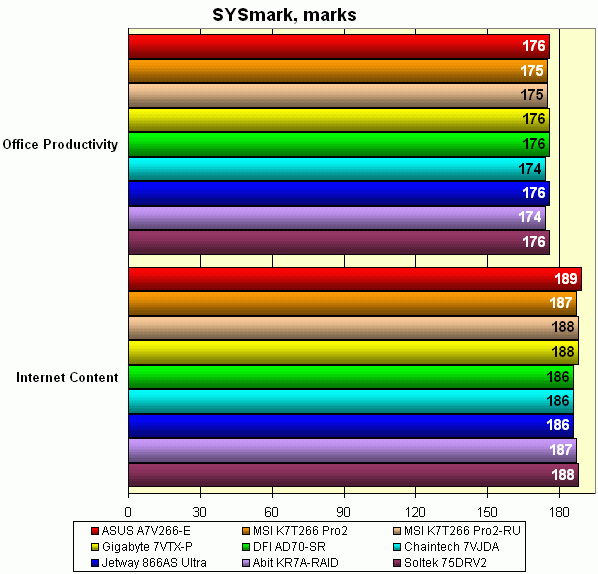 Let's look at the changes in the Content Creation Winstone:
As you can see, the Content Creation now includes new versions of the software. The key innovation is that the applications are tested in simultaneous operation. Before they were started one by one, contrary to the SYSmark. Now you can look at the test results, but the difference is too small to make any conclusions on the old and new versions of the Content Creation Winstone and on comparability with the SYSmark Internet Content Creation. The only interesting results are shown in the Business Winstone, where the Gigabyte has the worst scores. 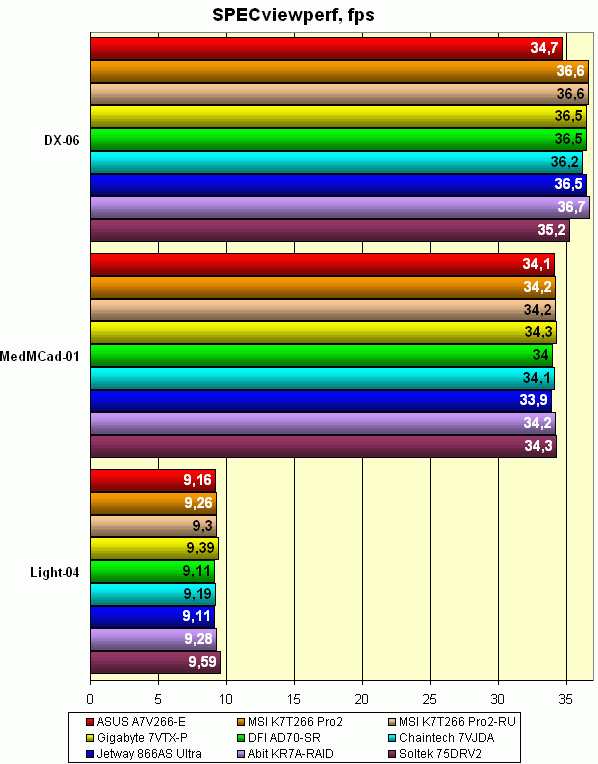 For this set of professional OpenGL applications we show you the results with the largest difference, which is still small. It is quite strange that the ASUS and the Soltek fall behind in the DX-06, the most memory dependent test.  The rendering speed in the 3DStudio MAX almost entirely depends on a processor, while it is almost impossible to overclock a CPU on a normal chipset. But it is not beyond the power of a mobo maker: he can overclock the bus just a little so that a 1600 MHz processor can work at a little higher frequency. In our test there are two such boards: from DFI and from Soltek (the Athlon worked at 1612 MHz on both boards, according to the WCPUID). But it didn't help the DFI AD70-SR either in this test or in any other.  The games prove that there is almost no difference in combined tests, though the Gigabyte and the Soltek are again ahead. 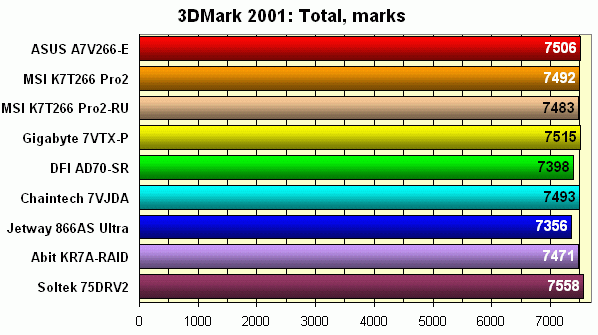 In the 3DMark the winners are again the Gigabyte and the Soltek, while the DFI and the Jetway are losers, though the speed gap is too narrow... ConclusionThe chipset is undoubtedly very good, and a user
has a wide choice of boards on it: the speediest board, the richest
in functions, the best overclockable one, the richest in accessories,
the cheapest etc. The last test is like a resumptive one for today:
it shows average performance scores of the tested boards.
Write a comment below. No registration needed!
|
Platform · Video · Multimedia · Mobile · Other || About us & Privacy policy · Twitter · Facebook Copyright © Byrds Research & Publishing, Ltd., 1997–2011. All rights reserved. | |||||||||||||||||||||||||||||||||||||||||||||||||||||||||||||||||||||||||||||||||||||||||||||||||||||||||||||||||||||||||||||||||||||||||||||||||||||||||||||||||||||||||||||||||||||||||||||||||